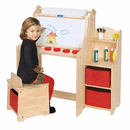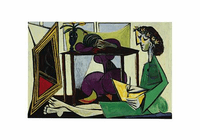3 TIPS FOR MAKING THE MOST OF YOUR NEXT DRAWING CLASS
3 TIPS FOR MAKING THE MOST OF YOUR NEXT DRAWING CLASS
By Greg Albert
In my opinion, a student's attitude is the most important factor contributing to a successful experience in a life-drawing class (or any class for that matter). Approach the class with the goal to learn as much as you can and don't compare your progress to that of other students, as doing so may either discourage you or falsely inflate your ego. Your goal in drawing class should be to derive the maximum benefit from your investment of time, money and energy.
Although you don't need to do anything to get ready for a drawing class—except acquire the needed supplies and equipment—a great way to prepare yourself is to read a good magazine on art technique or even browse through a few books on figure drawing from your local bookstore or library.
Don't skip any class sessions if you can avoid it. Regular attendance develops consistency and discipline and honors your teacher and classmates—they're learning from you, too.
Practice between classes, even for only 10 minutes. Keep sketchbooks handy, and when you have a spare moment make little sketches of people from memory, no matter how crude the results may seem. By the time you fill one sketchbook, you'll see an encouraging improvement. You'll be amazed at how much "talent" regular practice will reveal.
For more tips from Greg Albert on using life-drawing classes to supercharge your skills, see "Group Therapy" in the July 2005 issue of Drawing Board magazine. In this issue you’ll also discover how to tap into your creativity, learn all about drawing tools and how to use them, and work with pen and ink.
By Greg Albert
In my opinion, a student's attitude is the most important factor contributing to a successful experience in a life-drawing class (or any class for that matter). Approach the class with the goal to learn as much as you can and don't compare your progress to that of other students, as doing so may either discourage you or falsely inflate your ego. Your goal in drawing class should be to derive the maximum benefit from your investment of time, money and energy.
For more tips from Greg Albert on using life-drawing classes to supercharge your skills, see "Group Therapy" in the July 2005 issue of Drawing Board magazine. In this issue you’ll also discover how to tap into your creativity, learn all about drawing tools and how to use them, and work with pen and ink.
Copyright © 2002-2025 Madison Art Shop™ LLC. All Rights Reserved.


















